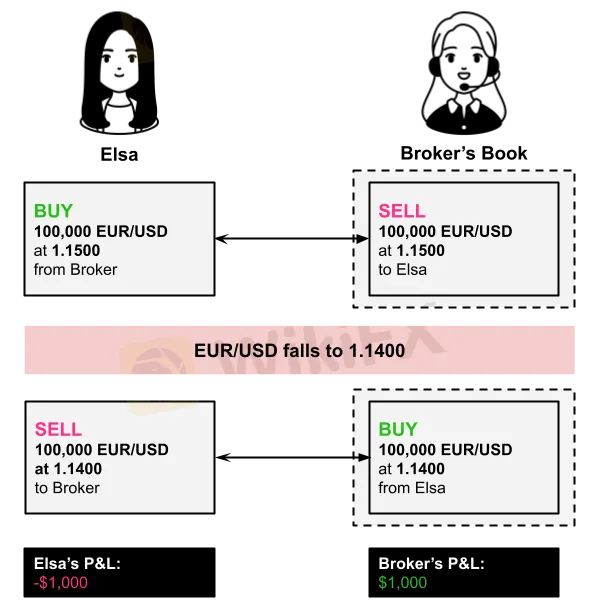Forex is a game that I enjoy playing
These champions have one thing in common: they not only work their butts off, but they also enjoy what they do.
简体中文
繁體中文
English
Pусский
日本語
ภาษาไทย
Tiếng Việt
Bahasa Indonesia
Español
हिन्दी
Filippiiniläinen
Français
Deutsch
Português
Türkçe
한국어
العربية
Abstract:When a retail forex broker takes the opposite of a customer's deal it has the option of either ACCEPTING or TRANSFERRING the market risk to another market participant. When a broker agrees to accept market risk when a trade is been carried out is referred to as “B-Book execution”. The act of taking the opposite of your transaction is called B-Booked execution. Your line of work is often known as "B-Booked."
When a retail forex broker takes the opposite of a customer's deal it has the option of either ACCEPTING or TRANSFERRING the market risk to another market participant.
When a broker agrees to accept market risk when a trade is been carried out is referred to as “B-Book execution”.
The act of taking the opposite of your transaction is called B-Booked execution.
Your line of work is often known as “B-Booked.”
Here are some more examples of industry lingo used to show that the broker has taken on risk:
· The threat has been “internalized” now.
· The threat has been “stored.”
Because the broker has decided to “keep” the risk, it has “internalized” it and “warehoused” it.
I'm not convinced market risk likes it when it's objectified.
Accepting market risk can be beneficial to the broker if the market swings in his favor or detrimental if the market swings against him.
Let's take a look at one of each.
B-Book Execution of the Order
Example #1: The Broker Comes Out on Top

Elsa went long 100,000 EUR/USD at 1.1500 in the example above. Her broker “B-Booked” (bet against) the trade and is now short 100,000 EUR/USD.
The pace of exchange of EUR/USD dropped to 1.1400.
Elsa can no longer handle it and sells 100,000 EUR/USD at 1.14000 to close her trade.
She loses $1,000 in the end.
P&L = (Exit Price - Entry Price) x Position Size
-1,000 = ((1.1400 - 1.1500) x 100,000)
The broker, on the other side, makes a $1,000 profit.
P&L = (Entry Price - Exit Price) x Position Size
1,000 = ((1.1500 - 1.1400) x 100,000)
The broker was rewarded with a PROFIT in this situation for accepting the market risk.
It was a successful outcome.
B-Book Order Execution
Example #2: Broker Losses
Now let's see what occurs when the market moves AGAINST the broker.

Elsa went long 100,000 EUR/USD at 1.1500 in the example above. Her broker “B-Booked” (bet against) the trade and is now short 100,000 EUR/USD.
The EUR/USD trades at 1.1700, up 200 pips.
Elsa chooses to take a profit and sells 100,000 EUR/USD at 1.17000 to close her trade.
She makes a $2,000 profit in the end.
P&L = (Exit Price - Entry Price) x Position Size
2,000 = ((1.1700 - 1.1500) x 100,000)
The broker, on the other hand, suffers a $2,000 loss.
P&L = (Entry Price - Exit Price) x Position Size
-2,000 = ((1.1500 - 1.1700) x 100,000)
The broker in this example lost money, which is the consequence of taking the market risk.
The outcome was unfavorable.
Here's how a B-Book broker makes money based on how a trade turns out:
| Customer‘s Trade | Broker’s Order Execution | Benefit |
| Win | B-Book (Accept risk) | Customer‘s gain is broker’s loss |
| Lose | B-Book (Accept risk) | Customer‘s loss is broker’s gain |
Conflict of Interest Possibilities
The B-Book has sparked a lot of debate during its execution.
There is a potential conflict of interest because your broker gains money if you lose money.
It gives the broker the ability to do “evil” things in order to raise up the odds of your trades failing.
Traders are concerned about immorality of brokers who do not want their customers to be successful due to this.
Because the focus of this course is on how forex brokers manage their market risk, we won't dive into examples of broker shadiness just yet (not how shady brokers take advantage of their customers).
For the time being, just be aware that when a forex broker chooses to accept market risk (“B-Book execution”), there is a potential conflict of interest between the broker and its customers.
We'll talk about another way a broker controls market risk in the following lesson: by transferring it (also known as “A-Book execution”).
Disclaimer:
The views in this article only represent the author's personal views, and do not constitute investment advice on this platform. This platform does not guarantee the accuracy, completeness and timeliness of the information in the article, and will not be liable for any loss caused by the use of or reliance on the information in the article.

These champions have one thing in common: they not only work their butts off, but they also enjoy what they do.

"Patience is the key to everything," American comic Arnold H. Glasgow once quipped. The chicken is gotten by hatching the egg rather than crushing it."

Ask any Wall Street quant (the highly nerdy math and physics PhDs who build complicated algorithmic trading techniques) why there isn't a "holy grail" indicator, approach, or system that generates revenues on a regular basis.

We've designed the School of WikiFX as simple and enjoyable as possible to help you learn and comprehend the fundamental tools and best practices used by forex traders all over the world, but keep in mind that a tool or strategy is only as good as the person who uses it.
